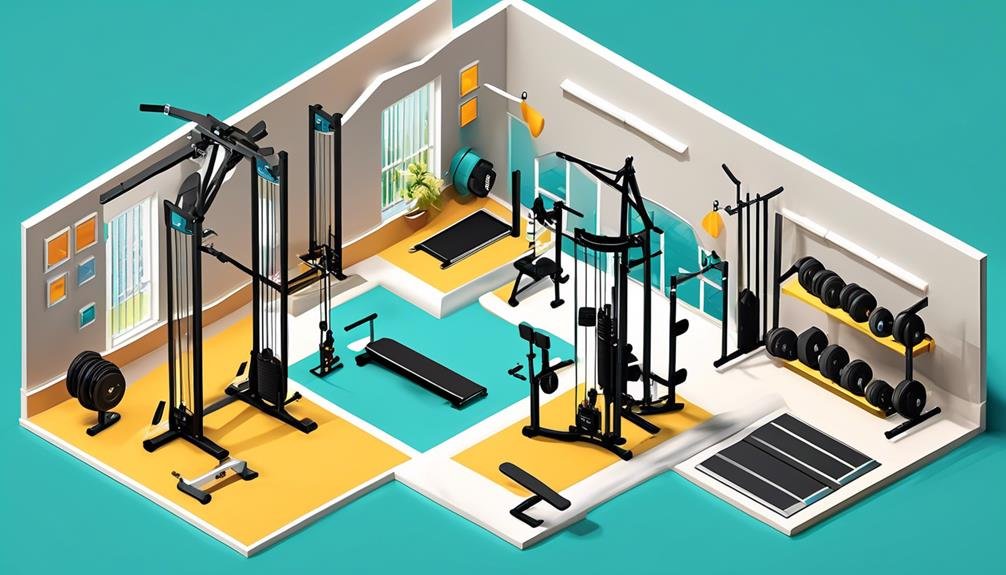Disclaimer: This content is for informational purposes only and does not replace professional medical advice, diagnosis, or treatment. Always consult a qualified healthcare provider before beginning any new exercise program.
'Look before you leap.' This old saying holds true when considering the safety of using wireless earbuds while lifting weights. While they offer convenience and a hands-free listening experience, it's important to understand the potential risks involved.
In this discussion, we'll explore the impact of music on lifting performance, the importance of proper fit and volume control, the limitations of noise-canceling features, and provide tips for safe and responsible use.
So, before you pop in those earbuds and hit the gym, let's examine whether they are truly safe for your workout routine.
Key Takeaways
- Wireless earbuds can pose potential risks to hearing health if used improperly, such as noise-induced hearing loss and the risk of infections.
- Music can have a positive impact on lifting performance, improving motivation, focus, and technique.
- Proper fit and volume control are crucial for safe and comfortable use of wireless earbuds.
- Noise-canceling features have limitations and may interfere with situational awareness and safety cues in the gym.
Potential Risks of Wireless Earbuds
Wireless earbuds pose potential risks that should be carefully considered before incorporating them into your lifting routine. While these devices offer convenience and freedom of movement, it's important to be aware of the potential drawbacks they may present.
One potential risk is the impact on hearing health. Excessive volume levels can lead to noise-induced hearing loss (NIHL), a condition that affects millions of people worldwide. The close proximity of wireless earbuds to the ear canal increases the risk of NIHL, especially if the volume is consistently set at high levels. It's crucial to be mindful of the volume and duration of use to minimize the risk of hearing damage.
Another concern is the potential for distraction. Engaging in physical activities such as lifting requires concentration and focus. Wireless earbuds, though providing an immersive audio experience, may divert your attention away from your workout, increasing the risk of accidents or injuries. It's recommended to use them in a controlled environment where distractions can be minimized.
Furthermore, wireless earbuds may pose a risk of bacterial or fungal infections. The warm and moist environment of the ear canal, combined with prolonged use of earbuds, creates an ideal breeding ground for microorganisms. Regular cleaning and proper hygiene practices can help mitigate this risk.
Impact of Music on Lifting Performance
Considering the potential risks associated with wireless earbuds, it is important to examine the impact of music on lifting performance. Music has long been used as a tool to enhance athletic performance, and lifting is no exception. Research has shown that listening to music while lifting can have several positive effects on performance.
Firstly, music has been found to increase motivation and arousal levels, leading to improved focus and effort during workouts. When you listen to music that you enjoy, it can help you get into the right mindset and push yourself harder. Additionally, music can help distract from feelings of fatigue and discomfort, allowing you to push through challenging sets and extend your workout duration.
Secondly, music has a rhythmical component that can help regulate movement and improve coordination. When you lift to the beat of the music, it can help you establish a consistent and efficient lifting tempo. This can enhance your lifting technique and reduce the risk of injury.
Lastly, music has the power to evoke emotional responses, which can enhance the overall lifting experience. Listening to uplifting and energetic music can boost mood, increase enjoyment, and promote a positive mindset during your workout.
Table: Impact of Music on Lifting Performance
| Effects of Music on Lifting Performance |
|---|
| Increased motivation and arousal levels |
| Improved focus and effort |
| Distraction from fatigue and discomfort |
| Regulation of movement and coordination |
| Enhanced lifting technique |
| Reduced risk of injury |
| Boosted mood and enjoyment |
| Promotion of a positive mindset |
Importance of Proper Fit and Volume Control

Proper fit and volume control are crucial factors to consider when using wireless earbuds for music while lifting.
Ensuring that your earbuds fit securely in your ears is important for several reasons. First, a proper fit helps to create an acoustic seal, minimizing external noise and allowing you to focus on your music without distractions. Additionally, a secure fit prevents your earbuds from falling out or moving around during your workout, which can be both inconvenient and potentially dangerous.
When it comes to volume control, it's essential to listen at a safe and comfortable level. Excessive volume can lead to noise-induced hearing loss, a condition that's irreversible. The World Health Organization recommends keeping the volume level below 85 decibels for a maximum of 8 hours per day to prevent hearing damage. Many wireless earbuds come with features such as volume limiting or built-in decibel meters to help you monitor and control the volume levels.
To ensure proper fit, choose earbuds that come with different sizes of ear tips, allowing you to find the best fit for your ears. It's also important to experiment with different sizes and styles of ear tips to find the most secure and comfortable fit.
When it comes to volume control, always start at a low volume and gradually increase it until you reach a level that's clear and audible, but not overly loud. Remember, your safety and well-being should always be prioritized when using wireless earbuds for music while lifting.
Limitations of Noise-Canceling Features
What are the limitations of noise-canceling features in wireless earbuds for music while lifting?
Noise-canceling features in wireless earbuds can enhance your listening experience by reducing background noise. However, it's important to understand their limitations to make an informed decision about using them while lifting. Here are some limitations to consider:
- Inability to block all external noise: While noise-canceling technology can significantly reduce low-frequency sounds like engine noise or air conditioning, it may not completely eliminate all external noise. This means that you may still hear some ambient sounds, including gym equipment or people talking.
- Interference with safety cues: Noise-canceling features can potentially interfere with your ability to hear important safety cues while lifting. For example, you may not be able to hear warning signals or instructions from gym staff, which could compromise your safety.
- Limited effectiveness with high-intensity workouts: Noise-canceling technology works best in relatively quiet environments. During high-intensity workouts, the increased ambient noise may reduce the effectiveness of noise-canceling features, making it difficult to fully enjoy the benefits.
- Reduced situational awareness: By canceling out external noise, noise-canceling features limit your ability to be aware of your surroundings. This can be a concern if you need to be attentive to potential hazards or interact with others in the gym.
- Battery life: Noise-canceling features require additional power, which can drain the battery of your wireless earbuds more quickly. This means that you may need to recharge them more frequently, which can be inconvenient during longer workouts.
While noise-canceling features offer certain benefits, it's essential to consider these limitations before using wireless earbuds for music while lifting. Understanding the potential drawbacks will help you make an informed decision that prioritizes your safety and listening experience.
Tips for Safe and Responsible Use

To ensure safe and responsible use of wireless earbuds for music while lifting, it's important to follow these tips.
- Be aware of the volume level. Listening to music at high volumes for extended periods can lead to hearing damage. It's recommended to keep the volume at a moderate level where you can still hear your surroundings.
- Take breaks. Continuous use of wireless earbuds can cause discomfort and potential hearing issues. It's advised to remove the earbuds every hour and allow your ears to rest.
- Maintain clean earbuds. Regularly clean your earbuds to prevent the buildup of dirt and bacteria, which can lead to ear infections. Use a soft, dry cloth to wipe the earbuds and avoid using water or cleaning solutions.
- Choose the right fit. Ill-fitting earbuds can cause discomfort and may fall out during physical activity. Select earbuds that come with different ear tip sizes to find the most comfortable and secure fit.
Conclusion and Final Thoughts
After considering the tips for safe and responsible use of wireless earbuds for music while lifting, it's important to reflect on the overall benefits and considerations of incorporating this technology into your fitness routine. Here are some final thoughts to help you make an informed decision:
- Convenience: Wireless earbuds provide a hassle-free experience, eliminating the need for tangled wires or worrying about accidentally yanking them out during your workout.
- Freedom of movement: With no wires to restrict your range of motion, wireless earbuds allow you to move freely and comfortably while lifting weights or performing other exercises.
- Sound quality: Many wireless earbuds offer exceptional sound quality, ensuring that you can enjoy your favorite music with crisp and clear audio while working out.
- Safety: By choosing wireless earbuds that have noise-canceling capabilities, you can block out external distractions and focus on your workout, potentially reducing the risk of accidents or injuries.
- Hygiene: Unlike traditional headphones, wireless earbuds are easier to clean and maintain, promoting better hygiene during your fitness sessions.
Frequently Asked Questions
What Are the Potential Long-Term Health Risks Associated With Using Wireless Earbuds While Lifting?
Using wireless earbuds while lifting may pose potential long-term health risks. These risks include hearing damage, as the close proximity of the earbuds to the eardrums can increase the volume of sound.
Can Listening to Music Through Wireless Earbuds Enhance My Lifting Performance?
Listening to music through wireless earbuds can enhance your lifting performance. Research suggests that music can increase motivation, reduce fatigue, and improve focus, leading to better workout results.
How Can I Ensure That My Wireless Earbuds Fit Properly to Prevent Any Discomfort or Pain During Lifting Sessions?
To prevent discomfort or pain during lifting sessions, ensure your wireless earbuds fit properly by selecting the right size ear tips, adjusting them securely in your ears, and avoiding excessive pressure on sensitive areas.
Are Noise-Canceling Features in Wireless Earbuds Completely Effective in Blocking Out External Sounds During Lifting Sessions?
Noise-canceling features in wireless earbuds can effectively block out external sounds during lifting sessions. However, the safety of wearing earbuds while lifting depends on proper fit, volume levels, and being aware of your surroundings to prevent accidents.
What Are Some Additional Safety Precautions or Guidelines I Should Follow When Using Wireless Earbuds While Lifting?
When using wireless earbuds while lifting, there are important safety precautions to consider. Ensure a secure fit to prevent them from falling out and becoming a distraction. Stay aware of your surroundings and use a comfortable volume level to avoid potential accidents.
Conclusion
In conclusion, wireless earbuds can be a safe option for listening to music while lifting, as long as certain precautions are taken.
It's important to consider the potential risks, such as hearing damage and distraction from surroundings, and to ensure proper fit and volume control.
While noise-canceling features can enhance the listening experience, they may also limit awareness of surroundings.
By following these tips for safe and responsible use, you can enjoy your music while lifting without compromising your safety.



